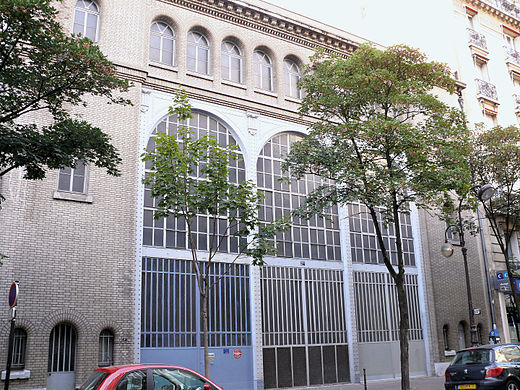
Uploaded on 2016-11-15 by Sociocognitive
(Attached photo from http://www.wikiwand.com/fr/Sous-station_Auteuil, Cf. (3) Energy) Stocks and flows (Paris, France) -------------------------------- (1) People (2) Food (3) Energy (4) Information Description: ------------ (1) People: People are moving daily into Paris from the suburbs to work (or for leisure etc.) while Paris residents are moving around. The centrally placed metro/train station (Châtelet--Les Halles) "has more passengers and trains than any other underground station in the world, about 750,000 passengers each day". Whenever an incident or a strike occurs, the traffic on the metro/train network gets so perturbed that anyone can observe a stock of people building up in the station, filling the platforms and extending to the corridors and halls of the station. * Link: http://www.ratp.fr/en/ratp/c_11162/chateletles-halles-rer-hub/ * Photos in: http://www.alamy.com/stock-photo/les-halles.html (2) Food: Supporting the population of the densely populated City of Paris demands large amounts of food incoming from mainly the countryside. The elaborate habits and tastes of the french population imply that a variety of fresh foods will be flowing into the city daily. Apart from big chain stores and small grocers, over ninety specialized outdoor markets exist all over Paris, as in other french cities, where customers may buy fresh foods (typically vegetables, fruits and fish, but also meat, poultry, cheese etc.). Any disturbance in the supply (flow) of foods, for example due to truckdriver strikes, leads to rapid depletion of the small stocks of fresh foods and to a temporary change in diet habits of the citizens, that tend to consume more grains, frozen foods etc. for which longer term stocks exist. * List of Paris open markets: http://marche.equipement.paris.fr/tousleshoraires * Photo of Place Maubert market: http://www.theramblingepicure.com/epicurean-adventure/place-maubert-paris-5th-arrondissement/ (3) Energy: As Paris (together with London) became a european super-city in the 19th century, the energy needs of the fast rising population had to be covered by new sources and so the use of electricity spreaded. A number of electric substations were established from late 19th to mid 20th century in Paris, some of which contitute nowadays protected cultural heritage sites. Energy (electricity) is produced in high tension sites and flows to substations where it gets transformed, but it is generally not stocked. * Photo of Auteuil substation http://www.wikiwand.com/fr/Sous-station_Auteuil * Bits of history of electricity in Paris (in french) http://www.parisapied.net/F%20imm%20ind%20AD.htm (4) Information: Paris, like any other bustling capital, is a center and a hub of information within its country (France) as well as internationally to a degree. The mass of information circulating (formally and informally, visibly and invisibly) may be deduced from the size and grandiosity of the Central Post Office (originally PTT, for Postal, Telegraph and Telephony Company) that dates back to the 19th century (inaugurated 1888). The bulk of ideas and innovations that have come out of Paris in this period of 150 years, in the cultural, commercial and economic domain is a proof that information is somehow "stocked" for some time, before being transformed into something new. * https://fr.wikipedia.org/wiki/Poste_centrale_du_Louvre * Photo of Central Post Office in: http://immobilier.lefigaro.fr/article/a-paris-la-poste-de-la-rue-du-louvre-entame-sa-mue_58f9d9ee-1c19-11e5-aff1-f06c473bc6fe/ Future of these stocks & flows: ------------------------------- (1) People. The information society infrastructure allows some flow to and from the city to be reduced, because some services (for example, banking) are provided via the internet or other electronic means. This tendency seems to be growing, although I believe it will come to a saturation point. This feature may also allow people to move back to the coutryside, thus acting counter to the urbanization trend. (2) Food. Although Paris is very dense, there are still many possibilities for urban farming. Urban farming can reduce the food flow needs and the dependence on external food sources, thus making the city more resilient. There are actually some ongoing urban farming projects. * http://foodtank.com/news/2014/08/Ten-urban-agriculture-projects-in-paris-france (3) Energy: Paris is well-known for being one of the first big cities to introduce a public bike rental service (Velib') thus reducing transportation load and assorted energy demands and carbon emissions. * http://en.velib.paris.fr/ The city of Paris also has a huge number of electric car charging sites as well as an electric car sharing service. * https://chargemap.com/city/paris * https://www.autolib.eu/en/how-does-it-work/service/ The electricity grid and energy generation from recycled waste are also ongoing projects. * http://www.paris-green.com/en/reseaux-energie/ (4) Information: As the world becomes more interconnected and physical and time-consuming transportation is replaced by tele-working with minimal cost, many more innovations are to be expected in all the domains of human activity and information is bound to grow. However, this is not necessarily a good thing, and many debates exist ...